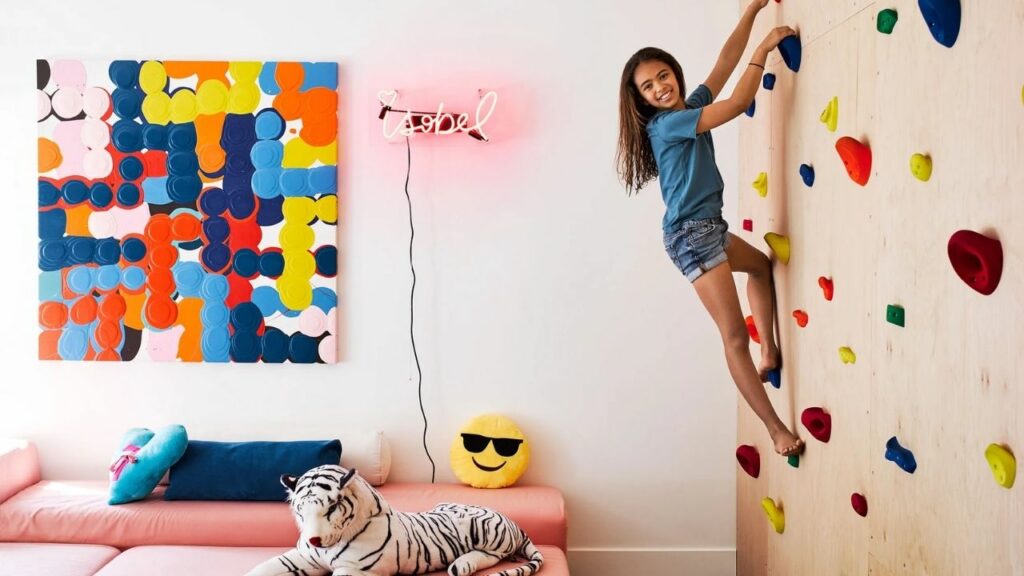Rock climbing is an adventurous and physically engaging activity that has gained immense popularity among people of all ages. While traditionally associated with outdoor terrains, indoor climbing walls have become a fantastic way to introduce children to the thrill and challenges of rock climbing in a controlled environment. Designing a climbing wall for kids goes beyond simply installing holds on a surface; it involves careful consideration of safety measures, age-appropriate challenges, and the integration of elements that stimulate young climbers both mentally and physically. In this article, we’ll delve into the essential aspects of creating a safe and stimulating environment when designing a rock climbing wall for kids.
Understanding the Significance of Kid-Friendly Climbing Walls
Indoor climbing walls designed specifically for kids serve as a bridge between the natural world of outdoor climbing and the controlled environment of indoor facilities. These walls allow children to develop fundamental climbing skills, enhance their coordination, build strength, and boost their confidence—all while having fun. The process of designing a kid-friendly climbing wall involves a thoughtful blend of safety measures and engaging elements that cater to the unique needs and abilities of young climbers.
Safety First: Designing with Kids’ Safety in Mind
When it comes to designing a rock climbing wall for kids, safety is paramount. Children are still developing their physical abilities and understanding of risks, making it crucial to design a climbing wall that minimizes potential hazards. To achieve this, the climbing wall should:
Choose Appropriate Holds and Grips: Select holds that are easy to grip and suit the size of children’s hands. These holds should be securely fastened to the wall to prevent accidents.
Set Age-Appropriate Challenges: Create climbing routes that match the skill levels of different age groups. Younger climbers should be provided with easier routes that allow them to build confidence gradually.
Include Safety Features: Install safety mats or crash mats around the climbing wall to cushion falls and reduce the risk of injury. Kids crash mats play a critical role in providing a soft landing surface.
Implement Proper Anchoring and Support: Ensure that the climbing wall is securely anchored to the floor and wall to prevent any instability while kids are climbing. The wall’s structure should be designed to withstand the dynamic movements of young climbers.
Stimulating the Young Mind: Designing for Mental Engagement
A kid-friendly climbing wall should not only offer physical challenges but also engage children’s minds in imaginative ways. Incorporating elements that stimulate mental growth and creativity can make the climbing experience even more rewarding:
Color-Coded Routes: Assign different colors to climbing routes of varying difficulty levels. This not only helps kids gauge their progress but also adds a visual element of excitement.
Interactive Holds: Integrate holds with unique textures, shapes, and designs to encourage kids to strategize and plan their moves as they ascend.
Storytelling Elements: Incorporate storytelling by designing climbing routes that follow a thematic narrative. This encourages children to use their imagination while climbing and adds an educational dimension to the activity.
Incorporate Playful Challenges: Include climbing challenges that require problem-solving, such as reaching a specific hold without touching the ground, which can enhance cognitive skills in a playful manner.
Choosing the Right Kids Crash Mats for Safety
One of the critical components of designing a safe climbing environment for kids is the inclusion of suitable crash mats. These mats provide a protective surface that minimizes the impact of falls, reducing the risk of injury. When selecting kids crash mats, consider the following factors:
Material Quality: Opt for crash mats made from high-density foam that offers optimal cushioning. The foam’s density determines its shock-absorbing ability.
Size and Coverage: Ensure that the crash mats cover a sufficient area around the climbing wall. This ensures that even if a child falls from various heights or angles, they will land on a padded surface.
Thickness: The thickness of the crash mats contributes to their shock-absorption capabilities. Thicker mats are generally more effective in reducing impact forces.
Ease of Maintenance: Choose crash mats with removable and washable covers. This allows you to maintain a clean and hygienic climbing environment for kids.
Conclusion
Designing a kid-friendly climbing wall is a blend of creativity, safety considerations, and an understanding of the unique needs of young climbers. By prioritizing safety measures such as appropriate holds, age-appropriate challenges, and properly designed kids crash mats, you can create an environment that fosters physical development, boosts confidence, and sparks imaginative growth. The combination of physical and mental engagement in a safe setting ensures that children not only enjoy their climbing experience but also gain valuable skills that will stay with them as they continue their journey in the world of rock climbing.
